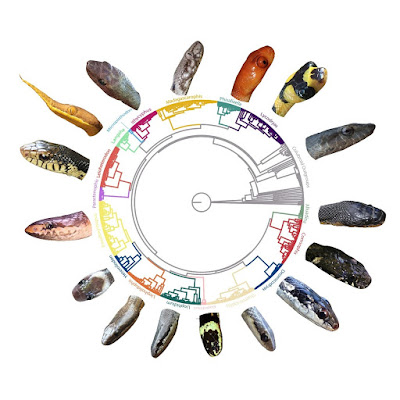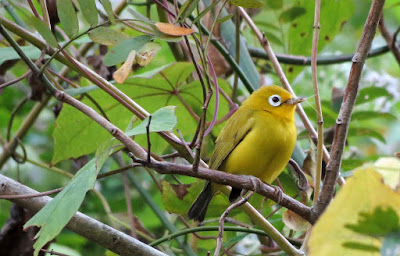[Most Recent Entries] [Calendar View]
Friday, April 26th, 2019
| Time | Event | ||||||
| 3:20a | [Herpetology • 2019] Achalinus juliani, A. timi & A. emilyae • Three New Species of the Snake Genus Achalinus (Squamata: Xenodermatidae) from Vietnam
Abstract Three new species of the xenodermatid genus Achalinus are described from northern Vietnam based on morphological and molecular evidence: Achalinus juliani sp. nov. is characterized by a combination of the following characters: 1) maxillary teeth 28; 2) suture between the internasals distinctly longer than that between the prefrontals; 3) internasal not fused to prefrontal; 4) loreal not fused with prefrontal; 5) infralabials 6; 6) mental separated from anterior chin shields; 7) two elongated anterior temporals, in contact with the eye, and two posterior temporals; 8) dorsal scales in 25–23–23 rows, keeled; 9) ventrals 173–179; 10) subcaudals 77–91, unpaired; 11) a total length of at least 413 mm (with a maximum tail length of 109 mm, and a tail/total length ratio of 0.22–0.37); 12) dorsum in preservative reddish to greyish brown above, with the lower and posterior head sides being paler; venter greyish cream, with the underside of the tail being somewhat darker. Achalinus timi sp. nov. is characterized by a combination of the following characters: 1) maxillary teeth 27; 2) suture between the internasals distinctly longer than that between the prefrontals; 3) loreal fused with the prefrontal on each side, with the prefrontal extending towards the supralabials; 4) dorsal scales in 25–25–23 rows, keeled; 5) ventrals 170+1; 6) subcaudals 72, unpaired; 7) a total length of at least 177.9 mm in males (with a tail length of 37.9 mm, and a tail/total length ratio of 0.21); 8) dorsum in preservative reddish to greyish brown above, with wide portion of the vertebral region being distinctly darker; the lower head sides somewhat paler; infralabial and chin shields light greyish brown; venter greyish cream, with the underside of the tail being somewhat darker and the chin region somewhat paler. Achalinus emilyae sp. nov. is characterized by a combination of the following characters: 1) maxillary teeth 27 or 28; 2) suture between internasals distinctly longer than that between the prefrontals; 3) internasal not fused to prefrontal; 4) loreal not fused with prefrontal; 5) infralabials 5; 6) mental separated from anterior chin shields; 7) two anterior temporals, only the upper one in contact with eye, and two posterior temporals; 8) dorsal scales in 23–23–23 rows, keeled; 9) ventrals in females 157–161; 10) subcaudals in females 63, unpaired; 11) a total length of at least 519.5 mm (with a maximum tail length of 95.1 mm, and a tail/total length ratio of 0.18 in females); 12) dorsum iridescent pale yellowish brown with a dark longitudinal mid-dorsal stripe. In terms of pairwise genetic distance (cytochrome c oxidase subunit 1, COI), the three new species differ by at least 12.7% from other members of the genus, including themselves. The total number of Achalinus known is increased to twelve and the number of Achalinus species known from Vietnam is increased from three to six. Currently ten species of xenodermatids are known to exist in Vietnam: Achalinus ater, A. emilyae, A. juliani, A. rufescens, A. spinalis, A. timi, Fimbrios klossi, F. smithi, Parafimbrios lao, and P. vietnamensis. Keywords: Serpentes, Achalinus, molecular phylogeny, morphology, new species, northern Vietnam, taxonomy, Reptilia Thomas Ziegler, Truong Quang Nguyen, Cuong The Pham, Tao Thien Nguyen, Anh Van Pham, Mona van Schingen, Tham Thi Nguyen, Minh Duc Le. 2019. Three New Species of the Snake Genus Achalinus from Vietnam (Squamata: Xenodermatidae). Zootaxa. 4590(2); 249–269. DOI: 10.11646/zootaxa.4590.2.3 | ||||||
| 4:00a | [Herpetology • 2019] The Origins and Diversification of the Exceptionally Rich Gemsnakes (Colubroidea: Lamprophiidae: Pseudoxyrhophiinae) in Madagascar
Abstract Processes leading to spectacular diversity of both form and species on islands have been well documented under island biogeography theory, where distance from source and island size are key factors determining immigration and extinction resistance. But far less understood are the processes governing in-situ diversification on the world’s mega islands, where large and isolated land masses produced morphologically distinct radiations from related taxa on continental regions. Madagascar has long been recognized as a natural laboratory due to its isolation, lack of influence from adjacent continents, and diversification of spectacular vertebrate radiations. However, only a handful of studies have examined rate shifts of in-situ diversification for this island. Here we examine rates of diversification in the Malagasy snakes of the family Pseudoxyrhophiinae (gemsnakes) to understand if rates of speciation were initially high, enhanced by diversification into distinct biomes, and associated with key dentition traits. Using a genomic sequence-capture dataset for 366 samples, we determine that all previously described and newly discovered species are delimitable and therefore useful candidates for understanding diversification trajectories through time. Our analysis detected no shifts in diversification rate between clades or changes in biome or dentition type. Remarkably, we demonstrate that rates of diversification of the gemsnake radiation, which originated in Madagascar during the early Miocene, remained steady throughout the Neogene. However, we did detect a significant slowdown in diversification during the Pleistocene. We also comment on the apparent paradox where most living species originated in the Pleistocene, despite diversification rates being substantially higher during the earlier 15 million years. Key Words: Pseudoxyrhophiinae, gemsnakes, island biogeography, in situ diversification, speciation, Neogene
Frank T. Burbrink, Sara Ruane, Arianna Kuhn, Nirhy Rabibisoa, Bernard Randriamahatantsoa, Achille P. Raselimanana, Mamy S. M. Andrianarimalala, John E. Cadle, Alan R. Lemmon, Emily Moriarty Lemmon, Ronald A. Nussbaum, Leonard Jones, Richard Pearson and Christopher J. Raxworthy. 2019. The Origins and Diversification of the Exceptionally Rich Gemsnakes (Colubroidea: Lamprophiidae: Pseudoxyrhophiinae) in Madagascar. Systematic Biology. syz026. DOI: 10.1093/sysbio/syz026 | ||||||
| 9:52a | [Ornithology • 2019] A Sympatric Pair of Undescribed White-eye Species (Zosteropidae: Zosterops) with Different Origins
Abstract Research in the Indo-Pacific region has contributed massively to the understanding of speciation. White-eyes (Aves: Zosteropidae: Zosterops), a lineage containing both widespread ‘supertramp’ species and a high proportion of island endemics, have provided invaluable models. Molecular tools have increased speciation research, but delimiting species remains problematic. We investigated the evolutionary history of Zosterops species in south-east Sulawesi using mitochondrial DNA, morphometric, song and plumage analyses, to draw species limits and assess which techniques offer best resolution. Our investigation revealed a novel Zosterops species, >3000 km from its closest relative. Additionally, we demonstrated unanticipated diversity in the alleged ‘supertramp’ Zosterops chloris and propose the Wakatobi Islands subspecies (Zosterops c. flavissimus) to be given full species status. Furthermore, we provide the first molecular and phenotypic assessment of the Sulawesi endemic Zosterops consobrinorum. While local populations of this species vary in either genetics or morphometrics, none show consistency across measures. Therefore, we propose no change to Zosterops consobrinorum taxonomy. This study gives insight into one of the great Indo-Pacific radiations and demonstrates the value of using multiple lines of evidence for taxonomic review. Keywords: birds, evolution, Indonesia, islands, new species, Wallacea
Darren P. O’Connell, David J. Kelly, Naomi Lawless, Katie O’Brien, Fionn Ó Marcaigh, Adi Karya, Kangkuso Analuddin and Nicola M Marples. 2019. A Sympatric Pair of Undescribed White-eye Species (Aves: Zosteropidae: Zosterops) with Different Origins. Zoological Journal of the Linnean Society. zlz022. DOI: 10.1093/zoolinnean/zlz022 Zoologists discover two new bird species in Indonesia phys.org/news/2019-04-zoologists-bird-sp |
| << Previous Day |
2019/04/26 [Calendar] |
Next Day >> |








